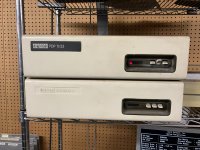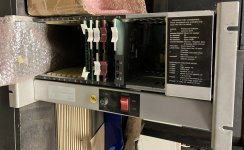tech58761
Experienced Member
So, at my work, in a room adjacent to my work area, are these two PDP-11s and which are used to run some automated electronics assembly equipment. Back in the 1990s, this equipment ran 8 hours a day, but now, it is barely run 8 hours a quarter. I think the only reason they haven't scrapped these two pieces of equipment is that the one customer for which we still have active programs hasn't officially discontinued the remaining boards for which we need these machines. There's an old 486 box down below which is apparently used to upload the program to the PDP (one is a spare) which then runs the equipment.
We are starting a plant rearrangement over the next calendar year, and it occurs to me there may be a slight chance that these could finally be retired within the next year or so.
Is there a list somewhere of boards that are particularly sought-after for PDP-11 machines? I cannot and will not commit to any timeline of these being available, but if and when that decision comes down, I want to be able to rescue these (and any spares) that would come available at that time. These machines are big and bulky enough I doubt very much the company would try and sell these on to new owners - especially since the equipment is well-worn and the industry's current emphasis on SMT over through-hole.

We are starting a plant rearrangement over the next calendar year, and it occurs to me there may be a slight chance that these could finally be retired within the next year or so.
Is there a list somewhere of boards that are particularly sought-after for PDP-11 machines? I cannot and will not commit to any timeline of these being available, but if and when that decision comes down, I want to be able to rescue these (and any spares) that would come available at that time. These machines are big and bulky enough I doubt very much the company would try and sell these on to new owners - especially since the equipment is well-worn and the industry's current emphasis on SMT over through-hole.


